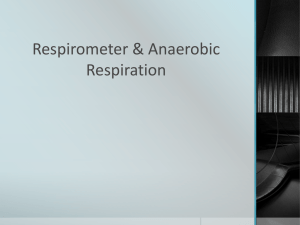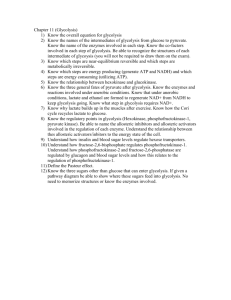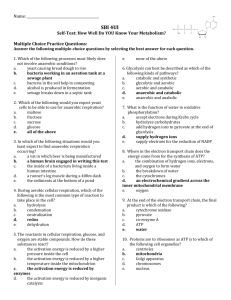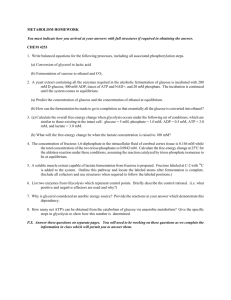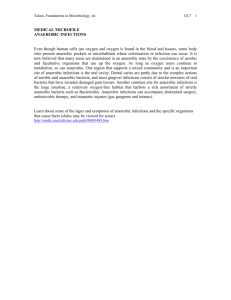AN INTRODUCTION TO METABOLISM Part 3: Anaerobic Metabolism *
advertisement
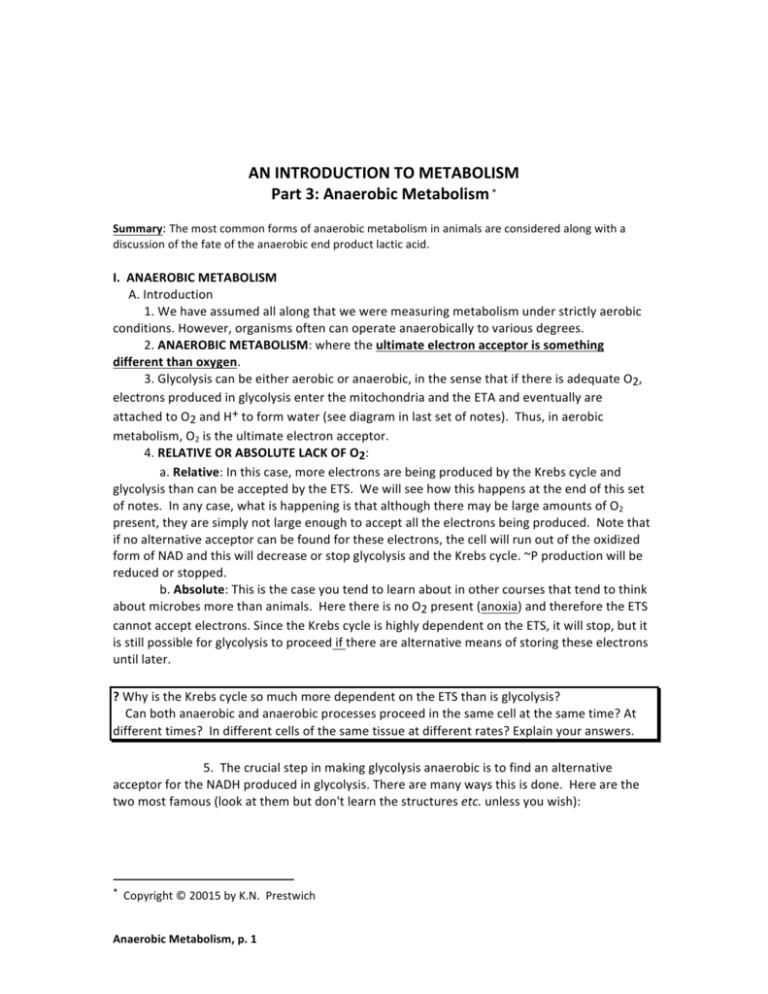
AN INTRODUCTION TO METABOLISM Part 3: Anaerobic Metabolism * Summary: The most common forms of anaerobic metabolism in animals are considered along with a discussion of the fate of the anaerobic end product lactic acid. I. ANAEROBIC METABOLISM A. Introduction 1. We have assumed all along that we were measuring metabolism under strictly aerobic conditions. However, organisms often can operate anaerobically to various degrees. 2. ANAEROBIC METABOLISM: where the ultimate electron acceptor is something different than oxygen. 3. Glycolysis can be either aerobic or anaerobic, in the sense that if there is adequate O2, electrons produced in glycolysis enter the mitochondria and the ETA and eventually are attached to O2 and H+ to form water (see diagram in last set of notes). Thus, in aerobic metabolism, O2 is the ultimate electron acceptor. 4. RELATIVE OR ABSOLUTE LACK OF O2: a. Relative: In this case, more electrons are being produced by the Krebs cycle and glycolysis than can be accepted by the ETS. We will see how this happens at the end of this set of notes. In any case, what is happening is that although there may be large amounts of O2 present, they are simply not large enough to accept all the electrons being produced. Note that if no alternative acceptor can be found for these electrons, the cell will run out of the oxidized form of NAD and this will decrease or stop glycolysis and the Krebs cycle. ~P production will be reduced or stopped. b. Absolute: This is the case you tend to learn about in other courses that tend to think about microbes more than animals. Here there is no O2 present (anoxia) and therefore the ETS cannot accept electrons. Since the Krebs cycle is highly dependent on the ETS, it will stop, but it is still possible for glycolysis to proceed if there are alternative means of storing these electrons until later. ? Why is the Krebs cycle so much more dependent on the ETS than is glycolysis? Can both anaerobic and anaerobic processes proceed in the same cell at the same time? At different times? In different cells of the same tissue at different rates? Explain your answers. 5. The crucial step in making glycolysis anaerobic is to find an alternative acceptor for the NADH produced in glycolysis. There are many ways this is done. Here are the two most famous (look at them but don't learn the structures etc. unless you wish): * Copyright © 20015 by K.N. Prestwich Anaerobic Metabolism, p. 1 H H O C (a) the production of lactic acid (lactate): C O C H LDH + NADH + H+ H O pyruvate H OH C C H H O +NAD+ C O lactate notice that all that happens is the central C of pyruvate is reduced. Thus lactate is simply reduced pyruvate. One reason for the common use of this particular pathway is that pyruvate production is the terminal step in glycolysis, therefore using it as an alternative electron acceptor in anaerobic glycolysis allows the entire process to be self-­‐contained. (b) the production of ethanol: H H C O C O H pyruvate O H C H C C + NADH + H+ + CO2 H H acetaldehyde O H H OH C C H H H +NAD+ ethanol (please note that the ethanol production reactions are not balanced as shown -­‐-­‐ in reality, a bit of water is involved). Anaerobic Metabolism, p. 2 6. So, here is what happens in anaerobic glycolysis in a typical animal: glucose glycogen ATP ADP Anaerobic Glycolysis G6P Pi ATP ADP F1',6' DP (P-6C-P) 2(NADH + H+) 2ATP 2ADP + 2Pi Glycolysis 2NAD+ 2ATP 2ADP 2 (lactate) 2 (pyruvate) knp CH3--CH -- COO| OH CH3--C -- COO|| O B. In the normal activities of an animal, there are many situations where anaerobic metabolism is significant. The most common situations are heavy exercise or any prolonged exercise in animals that are primarily "designed" for burst type activities. 1. The role of anaerobic glycolysis in the former group is to provide higher ~P production (metabolism) rates than can be sustained aerobically. This need typically occurs under high workload conditions such as sprinting. 2. Examples of latter would be many reptiles, amphibians, fish and spiders -­‐-­‐ animals that primarily capture prey by ambush or quick motion. These animals are also called "sit and wait" predators. If they are forced to exercise for long periods of time (meaning in this case more than few seconds) they rely on anaerobic metabolism as they simply lack well developed aerobic pathways. 3. Regardless of the animal, under any of these conditions, metabolism • measured as V O2 will underestimate the real metabolism, often by a great amount. C. What happens to the lactic acid? 1. The side effects of high [lactic acid]: the principal side effect of lactic acid is that it lowers cellular pH. This affects the conformation of all proteins within the cell. Generally Anaerobic Metabolism, p. 3 the cells can tolerate a degree of pH shift, but large amounts of lactic acid accumulate the pH change will be large enough to significantly affect the structures of a broad range of proteins. The result is the reduced function that we call fatigue. There are also psychological effects of high [lactic acid] -­‐-­‐ we generally experience such concentrations as a burning sensation in active muscles. 2. Removal of lactic acid: lactic acid is not a waste in animals. That is because it contains abundant energy (remember it is reduced pyruvic acid and pyruvic acid is normally oxidized in the Krebs cycle for energy). However, the cells that make lactic acid typically need to get rid of it because when they make it they are doing so because they lack sufficient O2 to oxidize it and also because of the pH problems just mentioned. And so, like in bacteria, the cells simply dump the lactate -­‐-­‐ in this case into the blood where it quickly is diluted and therefore causes less of a problem. As to what happens next, that depends: (a) the heart can oxidize lactate to CO2 and water. Lactate is a preferred fuel of the heart muscle. The heart usually has no trouble dealing with lactic acid since it has abundant O2. It handles it by reversing the LDH reaction to get NADH and pyruvate. The NADH is oxidized by the ETS to give ATP and the pyruvate proceeds through the Krebs cycle as usual. One can see that in this case glycolysis starts in some muscle tissue and produces lactic acid that is then oxidized in the heart. The net result is aerobic glycolysis where the first steps occur in the muscle (the anaerobic steps) and aerobic completion occurs in the heart. The heart may get 50% of more of its energy from lactic acid during exercise. (b) GLUCONEOGENESIS in this case the lactic acid is picked up by the liver (or sometimes other tissues). It is converted back to glucose at a net cost of energy (you don't simply reverse the reaction for the same amount of energy that was put in). Gluconeogenesis is an aerobic process. It generally proceeds at a slow rate. When associated with exercise, gluconeogenesis occurs mostly during the recovery period after the exercise (see next set of notes). Please note that gluconeogenesis is an umbrella term for a number of processes that produce glucose from other compounds. Starting points can also be a number of amino acids, Krebs cycle intermediates, or fatty acids. E. Since the accumulation of anaerobic products is associated with fatigue (as a result of a variety of complex mechanisms), activity with an appreciable anaerobic component can only be sustained for a limited duration of time. We refer to activities with appreciable anaerobic components as being NON-­‐STEADY STATE ACTIVITIES. Notice that here we use the term steady-­‐ state differently than when talking about the position of a reaction relative to equilibrium. Here it refers to whether or not the exercise can continue. F. Measuring the contribution of anaerobic metabolism to total metabolism. 1. To estimate anaerobic contributions to total metabolism, we need to know how much lactate accumulates during some activity. Notice that accumulation is key -­‐-­‐ if lactate is produced and oxidized at the same rate, the process is overall aerobic (see discussion of the heart immediately above). The accumulation is: lactate accumulated = final amount of lactate -­‐ initial amount of lactate Anaerobic Metabolism, p. 4 2. We need an equivalency between the amount of lactate that accumulates and the amount of energy released. This is a rather easy calculation. First we need to calculate the amount of hexose that was used: Glucose used = (lactate accumulated / 2) Since for each glucose we run through glycolysis, we get two lactic acid molecules. Next we need to know how much energy is released in going from glucose to lactate glucose -­‐-­‐-­‐-­‐> 2 lactate -­‐ 196.7 KJ/mol Given this, if we know the amount of glucose used from the lactate accumulation, then: Anaerobic Metabolism = mols glucose used * 196.7 KJ/mol = (mols lactate accumulated / 2) * 196.7 KJ/mol 3. Another interesting calculation is to find the proportion of the total amount of ATP synthesized in activity that came from anaerobic metabolism. Here's how this one is done: (a) From our knowledge of glycolysis we know that if we start with glycogen as fuel (generally the starting point in animals that are not exhausted or starved) then for each lactate that accumulates, we get 1.5 ~P (b) Likewise, for aerobic glycolysis (where no lactate is produced, but once again starting with glycogen) 37 ~P are synthesized per 6 O2 consumed or ~ 6.2 ~P/ mol O2 • (which is 0.277 mols of ~P per liter of O2 consumed). If this conversion is multiplied by V O2 , we can find the total ~P synthesized aerobically. (c) total energy made conserved in the anabolic processes of metabolism is then the sum of the aerobic and anaerobic processes. G. Efficiency of Anaerobic Glycolysis: 1. Recall that if we start from glucose our net yield of ~P is 2 per glucose; if from glycogen it is 3~P per hexose. If we use the standard free energy value for the hydrolysis of glucose (see last class), we get: from glucose: 2 ~P * 30.54 KJ = 61.08 kJ from glycogen: 3 ~P * 30.54 KJ = 91.63 kJ 2. We have seen earlier that the free energy released in going from glucose to lactate is: glucose -­‐-­‐-­‐-­‐> 2 lactate -­‐ 196.7 KJ/mol Anaerobic Metabolism, p. 5 3. And so, to keep this simple, if we assume standard free energy release from hydrolysis of ATP and if we start from glucose, then: Efficiency = 61.1 / 196.7 * 100 = 31% Not bad -­‐-­‐ but this is not the number (2%) you've seen in textbooks! To get that number we assume that whatever lactic acid is made will not be used as a fuel (this is a great assumption for microbes but a poor one for most animals). Using this assumption, the amount of energy potentially available in glucose is what would be obtained from complete oxidation: glucose + 6 O2 -­‐-­‐-­‐-­‐> 6 H2O + 6 CO2 -­‐ 2872 KJ and so the efficiency is: 2 ~P conserved = 61 KJ; 61 / 2872 * 100 = 2% So now you know! Another way to look at the difference between aerobic and anaerobic metabolism: how much more glucose must be used to pay a metabolic cost anaerobically than aerobically? G. One other important thing to know about anaerobic metabolism in animals and how it affects measurements of aerobic metabolism: • 1. NET PRODUCTION OF LACTATE GREATLY ALTERS V CO 2 . (a) Normally, there are large amounts of CO2 present in the blood. Most of it is in the form of bicarbonate (HCO3-­‐). (b) The H+ that accumulates during anaerobiosis drives CO2 out of solution by displacing the equilibrium of the reaction below to the left: H2O + CO2 <-­‐-­‐> H2CO3 <-­‐-­‐> HCO3-­‐ + H+ • 2. Thus, under conditions where anaerobic metabolism is occurring, V CO 2 is an essentially useless estimator of metabolism since its value is greatly affected by the amount of H+ that has been added to the blood. Anaerobic Metabolism, p. 6

